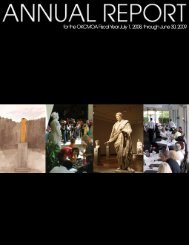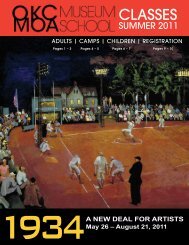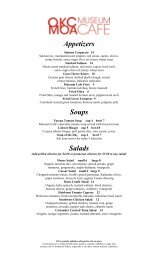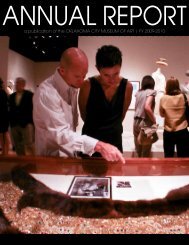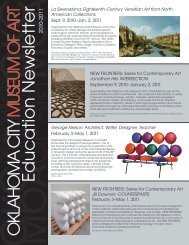Roman Art from the Louvre Educators' Resource Guide
Roman Art from the Louvre Educators' Resource Guide
Roman Art from the Louvre Educators' Resource Guide
Create successful ePaper yourself
Turn your PDF publications into a flip-book with our unique Google optimized e-Paper software.
9<br />
edifices dedicated to <strong>the</strong> administration of justice and o<strong>the</strong>r general affairs;<br />
curiae, where <strong>the</strong> senate assembled; and temples. Shops and markets were<br />
interspersed among <strong>the</strong>se public buildings and places of worship.<br />
Non-Citizens—Foreigners, Slaves, and Freedmen<br />
<strong>Roman</strong> law recognized three groups among <strong>the</strong> non-citizens who made up<br />
<strong>the</strong> majority of <strong>the</strong> empire’s population. First, <strong>the</strong>re were foreigners (called<br />
peregrine). Originally understood as anyone who did not follow <strong>the</strong> <strong>Roman</strong><br />
way of life, foreigners included free men in conquered provinces. After citizenship<br />
was granted to all freeborn persons in <strong>the</strong> empire in 212 A.D., <strong>the</strong><br />
label “foreigner” was no longer made used.<br />
Then <strong>the</strong>re were slaves, <strong>the</strong> vast labor force that was <strong>the</strong> backbone of <strong>the</strong> economy.<br />
Generally acquired as spoils of war, slaves were ethnically and culturally<br />
diverse. They and <strong>the</strong>ir families belonged to a public or private employer who<br />
could sell or rent <strong>the</strong>m out. Slaves were typically treated cruelly—<strong>the</strong>y could be<br />
killed by <strong>the</strong>ir master for any reason without legal consequence.<br />
Slaves performed a variety of necessary services and were <strong>the</strong>refore crucial<br />
to <strong>the</strong> economy of Rome. Some labored in municipal mines or on public<br />
building projects, while o<strong>the</strong>rs worked on farms owned by wealthy<br />
patricians. In <strong>the</strong> city, a slave might be employed as a household servant,<br />
a teacher for <strong>the</strong> master’s children, a craftsman, or even a doctor. Many<br />
earned notoriety and fame as participants in popular forms of entertainment,<br />
becoming gladiators, charioteers, or actors.<br />
Though <strong>the</strong> daily existence of slaves was generally unpleasant, <strong>the</strong>y were<br />
no doubt motivated by <strong>the</strong> prospect of possible freedom. Some owners<br />
freed <strong>the</strong>ir slaves as a benevolent gesture to <strong>the</strong>ir devoted servants; o<strong>the</strong>rs<br />
let <strong>the</strong>ir slaves go when <strong>the</strong>y grew old and less useful. The act of manumission<br />
liberated <strong>the</strong> slave and elevated his status to a freedman.<br />
Finally, <strong>the</strong>re were <strong>the</strong> freedmen, those who had been freed by <strong>the</strong>ir masters<br />
and no longer had slave status. Because <strong>Roman</strong> law looked favorably<br />
on those attempting to climb <strong>the</strong> social ladder, freedmen had <strong>the</strong> opportunity<br />
to achieve a higher status in society. Many freedmen, however, found<br />
it very difficult to overcome <strong>the</strong> stigma associated with slavery even after<br />
<strong>the</strong>y had achieved wealth and success.<br />
Although <strong>the</strong>y did not participate as political groups in <strong>the</strong> city’s life, foreigners,<br />
slaves, and freedmen never<strong>the</strong>less played a significant role in <strong>the</strong><br />
cultural and economic life of <strong>Roman</strong> civilization.




